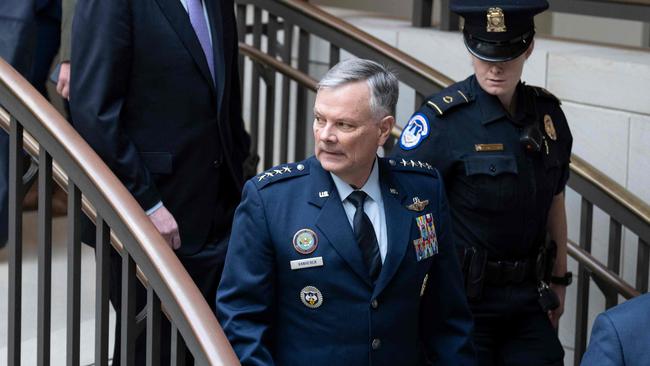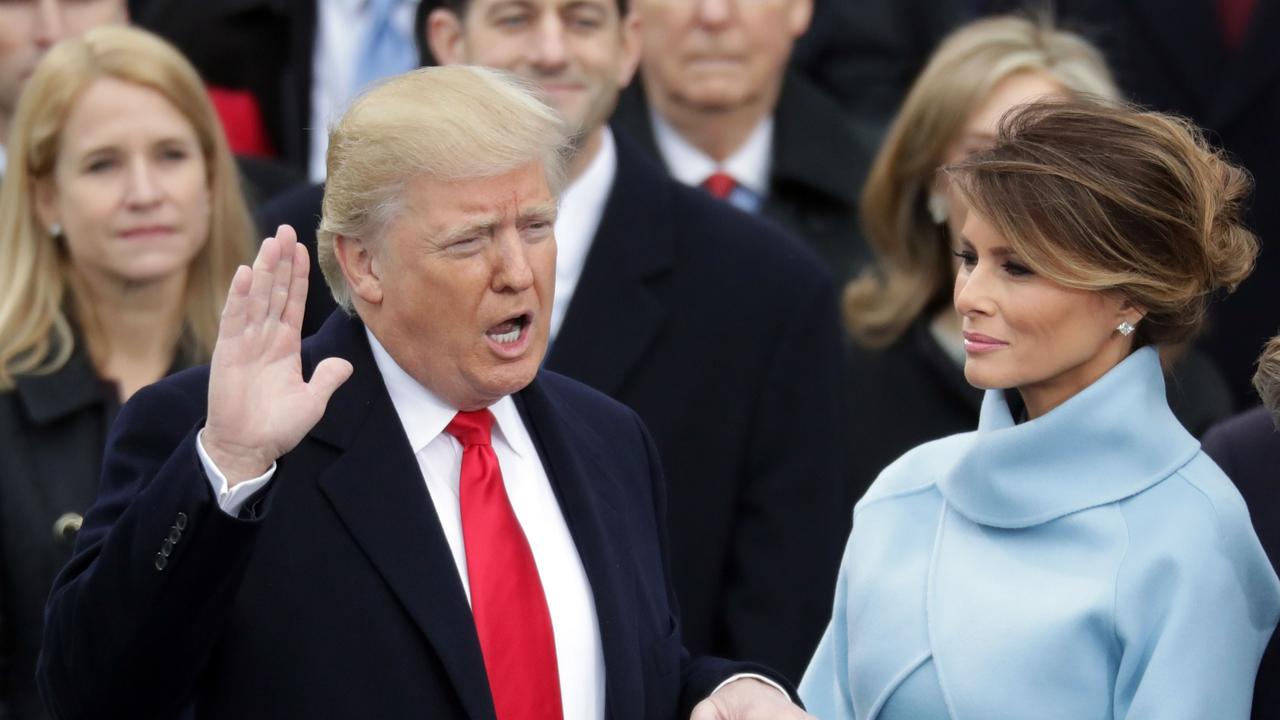Pentagon stumped as mystery drones swarmed military base
A swarm of mystery drones flew unhindered over Langley Air Force Base and other sensitive national security sites for nearly three weeks, with officials helpless to stop them.

US Air Force Gen. Mark Kelly wasn’t sure what to make of reports that a suspicious fleet of unidentified aircraft had been flying over Langley Air Force Base on Virginia’s shoreline.
Kelly, a decorated senior commander at the base, got on a squadron rooftop to see for himself. He joined a handful of other officers responsible for a clutch of the nation’s most advanced jet fighters, including F-22 Raptors.
For several nights, military personnel had reported a mysterious breach of restricted airspace over a stretch of land that has one of the largest concentrations of national-security facilities in the U.S. The show usually starts 45 minutes to an hour after sunset, another senior leader told Kelly.
The first drone arrived shortly. Kelly, a career fighter pilot, estimated it was roughly 20 feet long and flying at more than 100 miles an hour, at an altitude of roughly 3,000 to 4,000 feet. Other drones followed, one by one, sounding in the distance like a parade of lawnmowers.
The drones headed south, across Chesapeake Bay, toward Norfolk, Va., and over an area that includes the home base for the Navy’s SEAL Team Six and Naval Station Norfolk, the world’s largest naval port.
Officials didn’t know if the drone fleet, which numbered as many as a dozen or more over the following nights, belonged to clever hobbyists or hostile forces. Some suspected that Russia or China deployed them to test the response of American forces.
Federal law prohibits the military from shooting down drones near military bases in the U.S. unless they pose an imminent threat. Aerial snooping doesn’t qualify, though some lawmakers hope to give the military greater leeway.
Reports of the drones reached President Biden and set off two weeks of White House meetings after the drones first appeared in December last year. Officials from agencies including the Defense Department, Federal Bureau of Investigation and the Pentagon’s UFO office joined outside experts to throw out possible explanations as well as ideas about how to respond.
Drone incursions into restricted airspace was already worrying national-security officials. Two months earlier, in October 2023, five drones flew over a government site used for nuclear-weapons experiments. The Energy Department’s Nevada Nuclear Security Site outside Las Vegas detected four of the drones over three days. Employees spotted a fifth.
U.S. officials said they didn’t know who operated the drones in Nevada, a previously unreported incursion, or for what reason. A spokeswoman said the facility has since upgraded a system to detect and counter drones.

The sightings revealed the dilemma of defending against drones on U.S. soil compared with the ease of deploying or battling them abroad. Drones have become a deadly and cost-effective tool of war, capable of carrying surveillance gear, explosives or lethal chemicals. Yet shooting down suspicious aircraft over the U.S. risks disrupting or endangering the lives of Americans the military is sworn to protect.
Early last year, a suspected Chinese spy balloon crammed with electronic surveillance gear floated across the country for eight days, while military leaders waited for it to reach a spot isolated enough to shoot it down safely. After the balloon reached the Southeast coast, an F-22 jet from Langley punctured it with a missile.
Ten months later, the phalanx of drones appeared at Langley. Over 17 days, the drones arrived at dusk, flew off and circled back. Some shone small lights, making them look like a constellation moving in the night sky – or a science-fiction movie, Kelly said, “’Close Encounters at Langley.’”
They also were nearly impossible to track, vanishing each night despite a wealth of resources deployed to catch them.
Gen. Glen VanHerck, at the time commander of the U.S. Northern Command and the North American Aerospace Defense Command, said drones had for years been spotted flying around defence installations. But the nightly drone swarms over Langley, he said, were unlike any past incursion.
VanHerck, who led the military response to the Chinese balloon, ordered jet fighters and other aircraft to fly close enough to glean clues from the drones. He recommended that Defense Secretary Lloyd Austin authorise a full menu of electronic eavesdropping and spycraft to learn more, though the Pentagon is limited in what it can do on U.S. soil.
“If there are unknown objects within North America,” VanHerck said, the job is “to go out and identify them.” Solving that mystery, even for the world’s pre-eminent superpower, proved easier said than done. Local police were among the first to try.
For two nights, starting on Dec. 6, Hampton, Va., officers chased the drones, by patrol car and on foot, relaying momentary sightings along with information from Langley over police radios: One was seen in the area of Marshall Street or Gosnold’s Hope Park.
Three more appeared to land but returned to the air before officers could reach them. Another looked like it landed offshore. Police finally gave up.
Gen. Kelly, now retired, said the Pentagon was stumped, too. What would the U.S. do, he asked, “if this happens over the National Mall?” This account is based on interviews with more than two dozen government officials and other people familiar with the events, as well as police records, court documents and photographs of the drones.
Flying blind The drone swarm was reported to the Pentagon office of the National Military Command Center, which is responsible for dispersing emergency messages to U.S. military commanders worldwide.
A report went to the White House Situation Room, and the president learned about it in his daily briefing.

U.S. officials didn’t believe hobbyists were flying the drones, given the complexity of the operation. The drones flew in a pattern: one or two fixed-wing drones positioned more than 100 feet in the air and smaller quadcopters, the size of 20-pound commercial drones, often below and flying slower. Occasionally, they hovered.
They came from the north around 6pm to traverse the base, which sits on a peninsula at the mouth of Chesapeake Bay, and continued south, beyond the reach of radar. They repeated the pattern and then disappeared, typically by midnight.
Homeland Security Advisor Elizabeth Sherwood-Randall convened the White House brainstorming sessions. One official suggested using electronic signals to jam the drones’ navigation systems. Others cautioned that it might disrupt local 911 emergency systems and Wi-Fi networks.
One suggestion was to use directed energy, an emerging technology, to disable or destroy the drones. An FAA official said such a weapon carried too high a risk for commercial aircraft during the December holiday travel season.
Others suggested that the U.S. Coast Guard shoot nets into the air to capture the drones. An official pointed out that the Coast Guard might not have the authority to use such a weapon in this instance. Besides, the drones were too difficult to track closely.
Langley officials had called on U.S. Navy and Coast Guard ships to keep a watch out for the drones with little luck. They were much smaller than military aircraft and didn’t always show up on radar. Military personnel had to recalibrate their radar systems, which were set to ignore anything that resembled a bird.
Analysts learned that the smaller quadcopters didn’t use the usual frequency band available for off-the-shelf commercial drones – more evidence that the drone operators weren’t hobbyists.
Langley officials cancelled night-time training missions, worried about potential collisions with the drone swarm, and moved the F-22 jet fighters to another base. Base residents shared their sightings at the local Starbucks and posted blurry photos of the drones on private Facebook groups.
Intelligence officials spotted a vessel floating in international waters off the coast of Virginia and suspected a connection. Coast Guard crews boarded the vessel but found no computers or other gear to support the hunch.
On Dec. 23, the drones made their last visit.
In January, authorities found a clue they hoped would crack the case.
‘Worst spy ever’
During a rainy morning on Jan. 6, Fengyun Shi parked a rented Tesla near 65th Street and Huntington Avenue in Newport News, Va., 11 miles from the Langley base. The car was outside a shipyard run by HII, the company that builds nuclear submarines and the Navy’s newest generation of the Ford Class aircraft carrier.
Shi, a student at the University of Minnesota, told nearby residents around midmorning that he was flying a drone that got stuck in a tree. As he tried to free it using his controller a neighbour called Newport News, Va., police. Officers asked Shi why he was flying it in such foul weather, and they told him to call the fire department for help.
Shi instead returned his rental car an hour later and took an Amtrak train to Washington, D.C. The following day, he flew to Oakland, Calif. By chance, the drone fell to the ground that same day and ended up with federal investigators. FBI agents found that Shi had photographed Navy vessels in dry dock, including shots taken around midnight. Some were under construction at the nearby shipyard.
On Jan. 18, federal agents arrested Shi as he was about to board a flight to China on a one-way ticket. Shi told FBI agents he was a ship enthusiast and hadn’t realised his drone crossed into restricted airspace. Investigators weren’t convinced but found no evidence linking him to the Chinese government. They learned he had bought the drone on sale at a Costco in San Francisco the day before he travelled to Norfolk.
U.S. prosecutors charged Shi with unlawfully taking photos of classified naval installations, the first case involving a drone under a provision of U.S. espionage law. The 26-year-old Chinese national pleaded guilty and appeared in federal court in Norfolk on Oct. 2 for sentencing.
Magistrate Judge Lawrence Leonard said he didn’t believe Shi’s story -- that he had been on vacation and was flying drones in the middle of the night for fun. “There’s significant holes,” the judge said in court.
“If he was a foreign agent, he would be the worst spy ever known,” said Shi’s attorney, Shaoming Cheng.
“I’m sorry about what happened in Norfolk,” Shi said before he was sentenced to six months in federal prison.
US officials have yet to determine who flew the Langley drones or why. “This isn’t a tomorrow problem, this is a today problem,” said Tom Karako, senior fellow at the Center for Strategic and International Studies, a national-security think tank in Washington. “It’s not an over-there problem – it’s an over-there, over-here and everywhere problem.” US officials confirmed this month that more unidentified drone swarms were spotted in recent months near Edwards Air Force Base, north of Los Angeles.
Dow Jones




